 05-22-2020, 02:38 PM
05-22-2020, 02:38 PM
|
#1 (permalink)
|
|
Master EcoModder
Join Date: Jan 2008
Location: Sanger,Texas,U.S.A.
Posts: 16,514
Thanks: 24,517
Thanked 7,436 Times in 4,817 Posts
|
comment on 1st-gen Porsche 911/912 lift
When this topic came up it triggered something we talked about back in 5/16/2009, when Ernie Rogers shared his thread,'Describing my Beetle wing ( VW New Beetle)',here at EcoModder.
Julian's photograph of the 911,undergoing flow visualization with tufts,on the surface,does imply fully-attached flow,over nearly the entire aft-body of the Porsche. And it is, however, with a very important caveat, which Hucho addresses on page 114,Figure 4.10, Transverse velocity vector diagrams and drag coefficients for a fastback car with different rear end slope angles,after S.R.Ahmed,1984.
Ahmed presents a car model tested as a squareback,then the same vehicle as a a fastback,of varying rear slope angle.
As a squareback,with zero slope,the car registered Cd 0.272. As a fastback,with 15-degrees down-slope, the car registered its lowest drag,at Cd 0.23. When the same model's down-slope was increased to 30-degrees it registered its highest drag,at Cd 0.33.
Hucho comments, ' The C-pillar vortices are so strong that flow remains attached over almost all of the inclination. [T]he vortex strength is significantly higher on a fastback than a notchback,and decay of the vortex strength behind the vehicle is less pronounced. Beyond 30-degrees the vortex bursts and flow pattern changes to the squareback regime.
Elsewhere it's been mentioned that the attached,counter-rotating, longitudinal vortices allow for an attached downwash which gives the illusion of what would otherwise pass for 'attached flow' of the tufts,while not indicating the high-drag vortices which would only be visible on a grid screen or with smoke.
W.A.Mair and Rolf Buchheim et al research revealed that a turbulent boundary layer ( TBL ) cannot exist in an aft-body inclination steeper than 22-23 degrees. The trigger for separation.
The Porsche 911/912 rear slope is measured @ 26-degrees, indicating a compromised TBL. C-pillar tufts indicate cross-talk from the roof flow to the body side flow,an indication of the presence of attached vortices.
At 26-degrees,even though the tufts are apparently following the body contour,it would be impossible for the inviscid flow to be imparting any kinetic energy into the TBL.
Basically speaking,the flow is lost by the time it reaches the cooling air inlet, and any opportunity to decelerate and gain pressure over this region is lost to direct air heating, presenting a lower-than-attainable pressure 'OVER' the tail of the Porsche, allowing rear lift.
Both the duckbill and whaletail spoilers reach up and away from the low static pressure regime,into more energetic air,attempting to gain flow re-attachment, spoiling the lift.
By 1989,aero modifications for the 911 Carrera 4 cut drag from Cd 0.39,to Cd 0.32 without any significant 'visual' difference in the car.
After 1994,when the wasserboxer engines came onboard,Porsche lofted the rear end of the 911, softening the rear angle to 21.5-degrees.
In 1996,to win Le Mans, Porsche chose an 11.5-degree back slope foe their 911 GT1 racer, aft-body of 48% of total body length, and Verjungungsverhaltnisse of 2.209,achieving 210-mph on 600-horsepower. This car is a 'template' match.
The 2010 Porsche 918 Spyder, Cd 0.29,is also a 'template' match,incorporating only a 14.5-degree back slope, and is 'double-ended',with as much aft-body,as forebody.
Volkswagen also chose the 'template' for it's 2010 Lamborghini Sesto Elemento.
The center of the rear spoiler on the 2010 VW Audi R8 GT,runs right through the 'template.'
The Cd 0.29, 2010 Porsche Panamera is not far from it.
Even the VW Bugatti Veyron's 'low' spoiler flirts with it.
VW's 2011 Cd 0.186 XL1 is right on it.No spoiler.
VW's Lamborghini Aventador LP 700-4 goes beyond it a smidge (and no spoiler).
2011 Audi A8L, Cd 0.27 is dead on.
2011's Porsche 911 GTR RS 4.0 reaches above with it's rear wing for really clean air @ 193-mph.
VW's 2012 Audi A7 sticks it's pop-up spoiler right up to the 'template.'
VW's 2013 Lamborghini EGOISTA looks familiar.
A comparison of aft-bodies between the 1964 911/912 and 2014 911 bear very little resemblance.
VW chose the 'template' for it's 2017 Audi R8 V10 PLUS.
And today's Cd 0.25,Porsche Taycan Turbo S stays close to the profile.No spoiler.
I'm going to suggest that the beloved 911 was TBL flawed from the beginning,and after generations of Band-Aids added as palliatives, Volkswagen AG slowly distanced itself from the original 911 architecture,without alienating customers,and we'll probably never see aft-body contours like that again.And it wasn't so much lift due to an 'airfoil' shape that was responsible for instability,as it was low pressure caused by a corrupted boundary layer acting 'over' the rear body. Restore the 22-23-degree contour,and throw away the spoilers.
__________________
Photobucket album: http://s1271.photobucket.com/albums/jj622/aerohead2/
Last edited by aerohead; 05-22-2020 at 02:43 PM..
Reason: typing correction
|
|
|

|
 Today Today
|
|
|
|
 Other popular topics in this forum...
Other popular topics in this forum...
|
|
|
|
 05-22-2020, 04:14 PM
05-22-2020, 04:14 PM
|
#2 (permalink)
|
|
Banned
Join Date: Nov 2017
Location: Australia
Posts: 2,060
Thanks: 107
Thanked 1,608 Times in 1,137 Posts
|
Quote:
Originally Posted by aerohead

When this topic came up it triggered something we talked about back in 5/16/2009, when Ernie Rogers shared his thread,'Describing my Beetle wing ( VW New Beetle)',here at EcoModder.
Julian's photograph of the 911,undergoing flow visualization with tufts,on the surface,does imply fully-attached flow,over nearly the entire aft-body of the Porsche. And it is, however, with a very important caveat, which Hucho addresses on page 114,Figure 4.10, Transverse velocity vector diagrams and drag coefficients for a fastback car with different rear end slope angles,after S.R.Ahmed,1984.
Ahmed presents a car model tested as a squareback,then the same vehicle as a a fastback,of varying rear slope angle.
As a squareback,with zero slope,the car registered Cd 0.272. As a fastback,with 15-degrees down-slope, the car registered its lowest drag,at Cd 0.23. When the same model's down-slope was increased to 30-degrees it registered its highest drag,at Cd 0.33.
Hucho comments, ' The C-pillar vortices are so strong that flow remains attached over almost all of the inclination. [T]he vortex strength is significantly higher on a fastback than a notchback,and decay of the vortex strength behind the vehicle is less pronounced. Beyond 30-degrees the vortex bursts and flow pattern changes to the squareback regime.
Elsewhere it's been mentioned that the attached,counter-rotating, longitudinal vortices allow for an attached downwash which gives the illusion of what would otherwise pass for 'attached flow' of the tufts,while not indicating the high-drag vortices which would only be visible on a grid screen or with smoke.
W.A.Mair and Rolf Buchheim et al research revealed that a turbulent boundary layer ( TBL ) cannot exist in an aft-body inclination steeper than 22-23 degrees. The trigger for separation.
The Porsche 911/912 rear slope is measured @ 26-degrees, indicating a compromised TBL. C-pillar tufts indicate cross-talk from the roof flow to the body side flow,an indication of the presence of attached vortices.
At 26-degrees,even though the tufts are apparently following the body contour,it would be impossible for the inviscid flow to be imparting any kinetic energy into the TBL.
Basically speaking,the flow is lost by the time it reaches the cooling air inlet, and any opportunity to decelerate and gain pressure over this region is lost to direct air heating, presenting a lower-than-attainable pressure 'OVER' the tail of the Porsche, allowing rear lift.
Both the duckbill and whaletail spoilers reach up and away from the low static pressure regime,into more energetic air,attempting to gain flow re-attachment, spoiling the lift.
By 1989,aero modifications for the 911 Carrera 4 cut drag from Cd 0.39,to Cd 0.32 without any significant 'visual' difference in the car.
After 1994,when the wasserboxer engines came onboard,Porsche lofted the rear end of the 911, softening the rear angle to 21.5-degrees.
In 1996,to win Le Mans, Porsche chose an 11.5-degree back slope foe their 911 GT1 racer, aft-body of 48% of total body length, and Verjungungsverhaltnisse of 2.209,achieving 210-mph on 600-horsepower. This car is a 'template' match.
The 2010 Porsche 918 Spyder, Cd 0.29,is also a 'template' match,incorporating only a 14.5-degree back slope, and is 'double-ended',with as much aft-body,as forebody.
Volkswagen also chose the 'template' for it's 2010 Lamborghini Sesto Elemento.
The center of the rear spoiler on the 2010 VW Audi R8 GT,runs right through the 'template.'
The Cd 0.29, 2010 Porsche Panamera is not far from it.
Even the VW Bugatti Veyron's 'low' spoiler flirts with it.
VW's 2011 Cd 0.186 XL1 is right on it.No spoiler.
VW's Lamborghini Aventador LP 700-4 goes beyond it a smidge (and no spoiler).
2011 Audi A8L, Cd 0.27 is dead on.
2011's Porsche 911 GTR RS 4.0 reaches above with it's rear wing for really clean air @ 193-mph.
VW's 2012 Audi A7 sticks it's pop-up spoiler right up to the 'template.'
VW's 2013 Lamborghini EGOISTA looks familiar.
A comparison of aft-bodies between the 1964 911/912 and 2014 911 bear very little resemblance.
VW chose the 'template' for it's 2017 Audi R8 V10 PLUS.
And today's Cd 0.25,Porsche Taycan Turbo S stays close to the profile.No spoiler.
I'm going to suggest that the beloved 911 was TBL flawed from the beginning,and after generations of Band-Aids added as palliatives, Volkswagen AG slowly distanced itself from the original 911 architecture,without alienating customers,and we'll probably never see aft-body contours like that again.And it wasn't so much lift due to an 'airfoil' shape that was responsible for instability,as it was low pressure caused by a corrupted boundary layer acting 'over' the rear body. Restore the 22-23-degree contour,and throw away the spoilers.
|
That's all very complex, and I think it is in large part wrong. I don't have any emotional capital invested in defending a template - just as with closed/open wheels, I just report on what the research and my measurements show.
Porsche without rear spoiler, generating lots of lift. Note attached flow (not "implied fully attached flow") on roof down to tail:

Porsche with rear spoiler, generating less lift. Note separated flow:
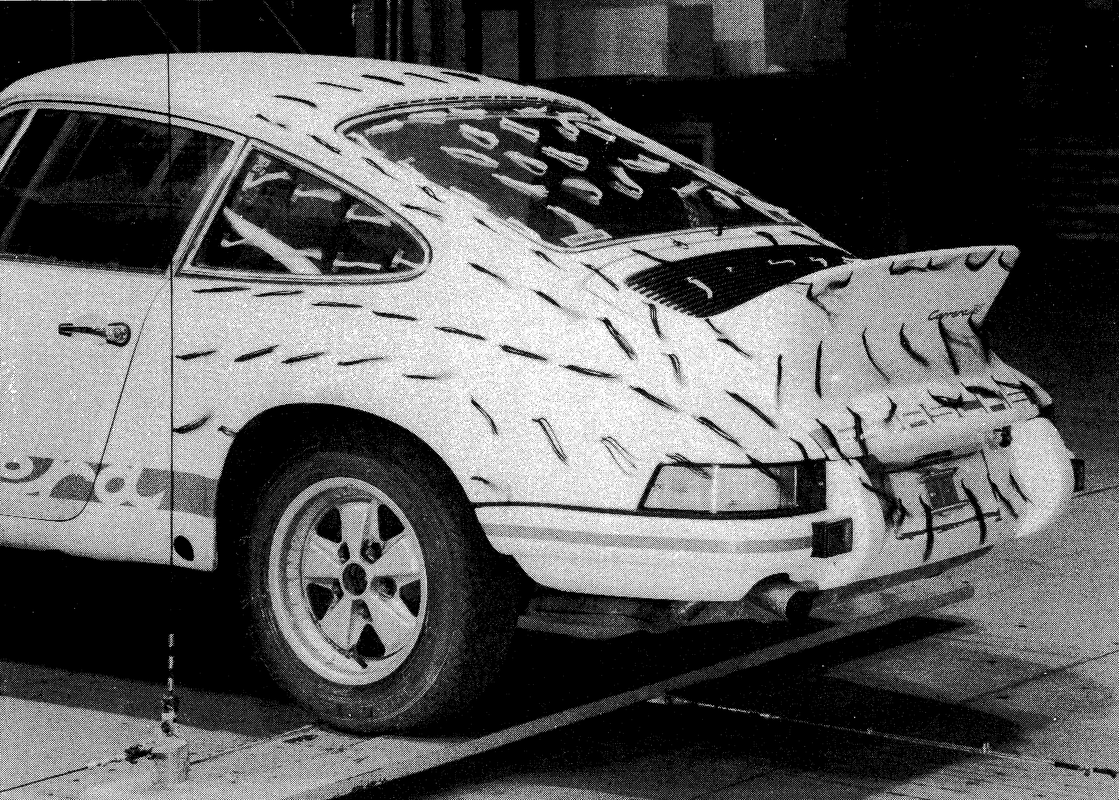
Separating the flow caused less lift - the opposite of what you argue. (Of course that's where the word 'spoiler' originally came from - ie spoiling the attached flow.)
My actual pressure measurements on Jaguar XE. These measurements matched Jaguar's CFD very well, and were also endorsed by Jaguar's chief aerodynamicist. Note that whenever attached airflow wraps around upper curves, a low pressure (ie lift) is generated:
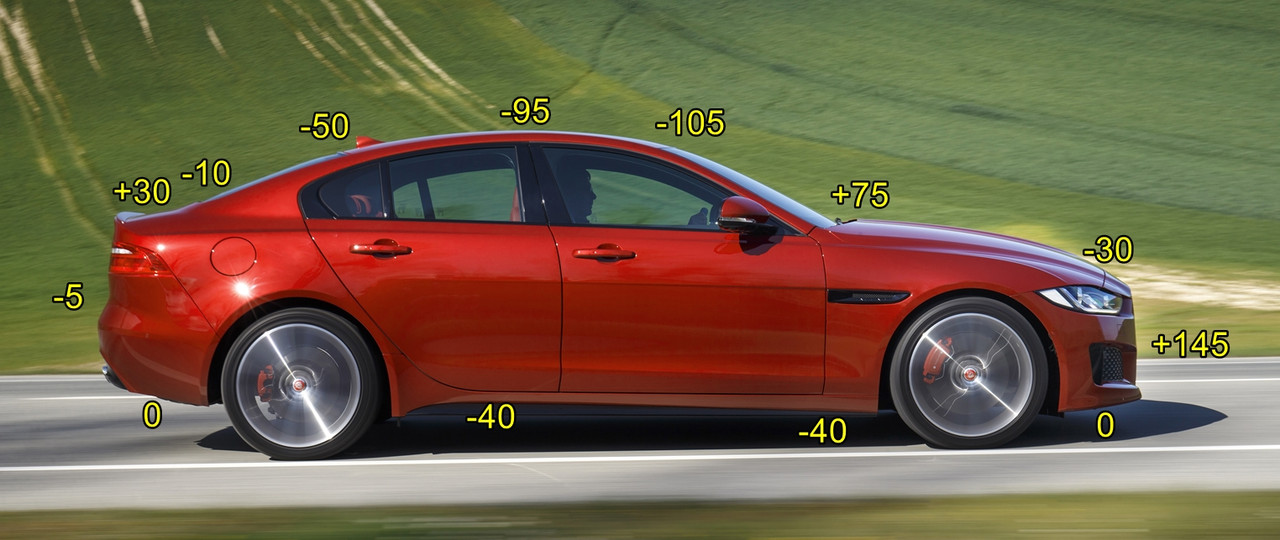 The idea that lift is generated only by separated flow is simply not the case.
The idea that lift is generated only by separated flow is simply not the case.
It is misleading to constantly suggest that lift involves separated flow. The evidence does not support that statement. It may have been the case in the distant past where separation was much more common (eg at the end of the roof in 1960s sedans); it is not the case in today's cars where separation is delayed as late as possible.
And I reiterate: I have never seen any mention of The Template (or its equivalent shape) in any current aerodynamic technical literature on road cars.
There is no issue in upper surfaces generating low pressures if those are offset by low pressures generated under the car.
But look, the days when all this had to be argued by invoking obscure theory are now gone: just use the techniques I cover in my book to measure real pressures on real cars on real roads. When you do so, you will see that attached airflow wrapping over upper curves generates low pressures (ie lift) - and that's hardly a surprise. Measurement, not theory.
|
|
|

|
|
The Following User Says Thank You to JulianEdgar For This Useful Post:
|
|
 05-22-2020, 05:01 PM
05-22-2020, 05:01 PM
|
#3 (permalink)
|
|
Master EcoModder
Join Date: Jan 2008
Location: Sanger,Texas,U.S.A.
Posts: 16,514
Thanks: 24,517
Thanked 7,436 Times in 4,817 Posts
|
lift and separated flow
Quote:
Originally Posted by JulianEdgar

That's all very complex, and I think it is in large part wrong. I don't have any emotional capital invested in defending a template - just as with closed/open wheels, I just report on what the research and my measurements show.
Porsche without rear spoiler, generating lots of lift. Note attached flow (not "implied fully attached flow") on roof down to tail:

Porsche with rear spoiler, generating less lift. Note separated flow:

Separating the flow caused less lift - the opposite of what you argue. (Of course that's where the word 'spoiler' originally came from - ie spoiling the attached flow.)
My actual pressure measurements on Jaguar XE. These measurements matched Jaguar's CFD very well, and were also endorsed by Jaguar's chief aerodynamicist. Note that whenever attached airflow wraps around upper curves, a low pressure (ie lift) is generated:
 The idea that lift is generated only by separated flow is simply not the case.
The idea that lift is generated only by separated flow is simply not the case.
It is misleading to constantly suggest that lift involves separated flow. The evidence does not support that statement. It may have been the case in the distant past where separation was much more common (eg at the end of the roof in 1960s sedans); it is not the case in today's cars where separation is delayed as late as possible.
And I reiterate: I have never seen any mention of The Template (or its equivalent shape) in any current aerodynamic technical literature on road cars.
There is no issue in upper surfaces generating low pressures if those are offset by low pressures generated under the car.
But look, the days when all this had to be argued by invoking obscure theory are now gone: just use the techniques I cover in my book to measure real pressures on real cars on real roads. When you do so, you will see that attached airflow wrapping over upper curves generates low pressures (ie lift) - and that's hardly a surprise. Measurement, not theory. |
*We know that all wings can produce zero lift.Yes? (I gave you 118 examples).
*The lowest pressure on an automobile occurs just ahead of the windshield header.
*All the air on the car would like to go to the low pressure area near windshield header.
*On the aft-body,the only reason air isn't flowing forwards to the windshield header is because kinetic energy from inviscid flow is attacking and energizing the TBL, all the way to the body 'wall.'
*If the aft-body slope exceeds 22-23-degrees,the inviscid flow can no longer impart enough energy to the TBL to prevent stall,reversion,eddy formation,then full-blown turbulence.The air at the wall boundary is already at rest.The pressure rise presented by the radical downslope would demand (from the Bernoulli Theorem) that the flow decelerate.Since the flow at the wall is already zero,that's impossible. Which results in counterflow on the roof,moving forwards towards the windshield,rolling up into eddies,then turbulence,lifting off the roof as separation.At this point the flow is lost and all the kinetic energy of the turbulence is converted to heat,through viscous attrition,downstream.
If the roofline were streamlined,there'd be no separation,no turbulence,no lost energy.
Smoke flow images of the 911 would really help. Beetle images clearly show the separation. Smoke flow images of the Volkhart V2 Saggitta,very similar to the 1939 Porsche 60K10 also show the separation.
I believe that you'd see the separation on the 911,you'd see the attached longitudinal vortices,which would explain the illusion of 'attached flow' with the tufts.
The roof acts as a deceleration ramp,allowing the air to resume its position and original,local barometric pressure as it possessed before encountering the car in the first place.
With a streamlined roof,the air would be at the same pressure as the nose,minus the skin friction loss. This high pressure,'slow' air would not generate the lift as one might imagine and it's the reason Volkswagen Group no longer builds a car like the 1st-gen 911.
A spoiler spoils lift.Lift is a function of low pressure acting 'over' a portion of the body.All separation should be at the back of the car. If it's not,it's in a lower pressure regime,as it's at a higher velocity.The closer you get to the windshield the lower the pressure and the higher the lift.
All streamline filaments about the body are isoenergetic. They possess exactly the same amount of energy.They can be mostly high velocity and low pressure, visa versa,or somewhere in between.
I recommend you review your text on fluid mechanics or Hucho's treatment of it in his second edition. It's imperative that you understand Bernoulli.
__________________
Photobucket album: http://s1271.photobucket.com/albums/jj622/aerohead2/
|
|
|

|
 05-22-2020, 06:48 PM
05-22-2020, 06:48 PM
|
#4 (permalink)
|
|
Banned
Join Date: Nov 2017
Location: Australia
Posts: 2,060
Thanks: 107
Thanked 1,608 Times in 1,137 Posts
|
Quote:
Originally Posted by aerohead

*We know that all wings can produce zero lift.Yes? (I gave you 118 examples).
*The lowest pressure on an automobile occurs just ahead of the windshield header.
*All the air on the car would like to go to the low pressure area near windshield header.
*On the aft-body,the only reason air isn't flowing forwards to the windshield header is because kinetic energy from inviscid flow is attacking and energizing the TBL, all the way to the body 'wall.'
*If the aft-body slope exceeds 22-23-degrees,the inviscid flow can no longer impart enough energy to the TBL to prevent stall,reversion,eddy formation,then full-blown turbulence.The air at the wall boundary is already at rest.The pressure rise presented by the radical downslope would demand (from the Bernoulli Theorem) that the flow decelerate.Since the flow at the wall is already zero,that's impossible. Which results in counterflow on the roof,moving forwards towards the windshield,rolling up into eddies,then turbulence,lifting off the roof as separation.At this point the flow is lost and all the kinetic energy of the turbulence is converted to heat,through viscous attrition,downstream.
If the roofline were streamlined,there'd be no separation,no turbulence,no lost energy.
Smoke flow images of the 911 would really help. Beetle images clearly show the separation. Smoke flow images of the Volkhart V2 Saggitta,very similar to the 1939 Porsche 60K10 also show the separation.
I believe that you'd see the separation on the 911,you'd see the attached longitudinal vortices,which would explain the illusion of 'attached flow' with the tufts.
The roof acts as a deceleration ramp,allowing the air to resume its position and original,local barometric pressure as it possessed before encountering the car in the first place.
With a streamlined roof,the air would be at the same pressure as the nose,minus the skin friction loss. This high pressure,'slow' air would not generate the lift as one might imagine and it's the reason Volkswagen Group no longer builds a car like the 1st-gen 911.
A spoiler spoils lift.Lift is a function of low pressure acting 'over' a portion of the body.All separation should be at the back of the car. If it's not,it's in a lower pressure regime,as it's at a higher velocity.The closer you get to the windshield the lower the pressure and the higher the lift.
All streamline filaments about the body are isoenergetic. They possess exactly the same amount of energy.They can be mostly high velocity and low pressure, visa versa,or somewhere in between.
I recommend you review your text on fluid mechanics or Hucho's treatment of it in his second edition. It's imperative that you understand Bernoulli.
|
Well, you could write lots of stuff that justifies your position on a purely theoretical basis - or you could just look at:
- the tuft images from Porsche
- the actual on-road measurements I have made.
Statements like "Which results in counterflow on the roof,moving forwards towards the windshield,rolling up into eddies,then turbulence,lifting off the roof as separation" are simply rubbish. No tuft testing shows flow separation on the roof on any modern car. None.
(But then a moment ago you explained away the Porsche tuft testing because it didn't match your theory. Those tufts were just an " illusion of 'attached flow'". Talk about mental gymnastics!)
Honestly, why don't you get away from the keyboard and measure some pressures and flows on real cars on real roads? You will very quickly find those measurements don't support your theory.
(You say you have my book. Look on page 80. More measured pressures that don't match your theory!) |
|
|

|
|
The Following User Says Thank You to JulianEdgar For This Useful Post:
|
|
 05-23-2020, 04:20 AM
05-23-2020, 04:20 AM
|
#5 (permalink)
|
|
Banned
Join Date: Nov 2017
Location: Australia
Posts: 2,060
Thanks: 107
Thanked 1,608 Times in 1,137 Posts
|
Raining and a miserable day here, so out of interest I just went back to my aero textbooks and looked at what they had to say on the subject of lift.
Aerohead's theory is completely wrong, and even his favourite reference (Hucho, 1987) doesn't support his theory.
If anyone is interested, I can quote specifics from Katz, Barnard and Hucho. Barnard is the clearest.
|
|
|

|
|
The Following User Says Thank You to JulianEdgar For This Useful Post:
|
|
 05-23-2020, 06:48 PM
05-23-2020, 06:48 PM
|
#6 (permalink)
|
|
EcoModding Lurker
Join Date: Jul 2012
Location: Warsaw, Poland
Posts: 62
Thanks: 52
Thanked 17 Times in 8 Posts
|
Quote:
Originally Posted by JulianEdgar

If anyone is interested, I can quote specifics from Katz, Barnard and Hucho. Barnard is the clearest.
|
Interested, please do! |
|
|

|
 05-23-2020, 07:55 PM
05-23-2020, 07:55 PM
|
#7 (permalink)
|
|
Banned
Join Date: Nov 2017
Location: Australia
Posts: 2,060
Thanks: 107
Thanked 1,608 Times in 1,137 Posts
|
Quote:
Originally Posted by maczo

Interested, please do!
|
Aerohead's theory is that lift is caused by separation, rather than attached flow. He also suggests that well-streamlined bodies have low lift.
However, in fact it is the airflow wrapping around the upper curves that is the primary cause of lift. Therefore, low drag shapes that have upper curves coming down to a small wake area have higher lift.
Aerodynamics of Road Vehicles, 1987, Hucho (ed), Page 281:
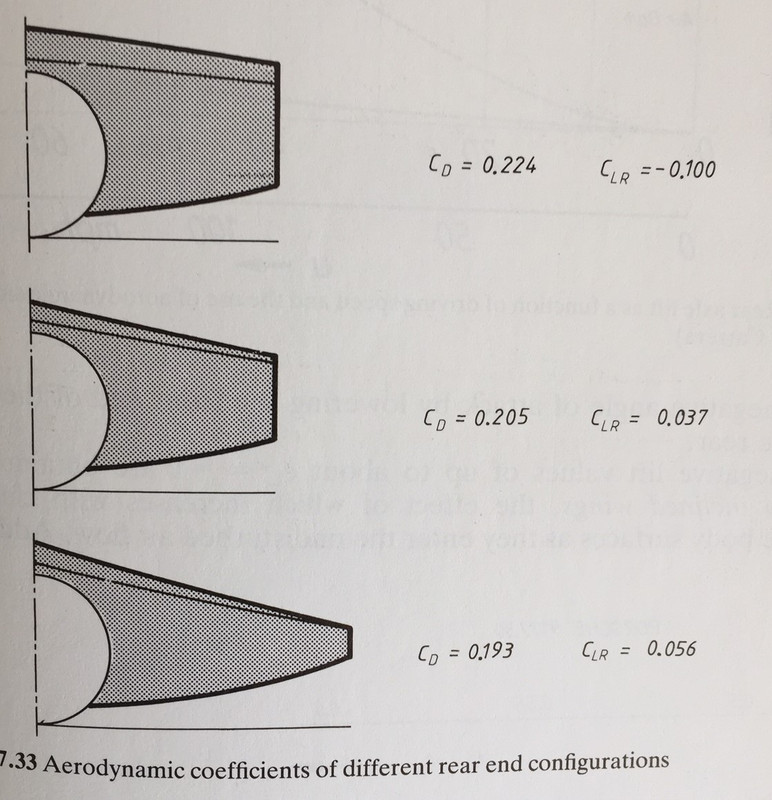
You can see that as the camber (upper curve) of the body becomes greater and longer (ie giving a smaller wake), Cd drops from 0.224 to 0.193 but the CLr (rear lift) rises from -0.1 to 0.056. Well streamlined bodies do not always have lower lift! In fact, because on road cars they need to have greater camber, lift (especially at the rear) is likely to be increased as wake area decreases.
Road Vehicle Aerodynamic Design, 2009, Barnard, Page 32.

You can see that lift is dependent on two aspects - degree of camber and angle of attack. The cambered shape gives more lift at all angles of attack.
Edit addition: and note how lift actually declines with flow separation!
Barnard immediately then goes on to this:

Note the reduced pressure over the cambered car shape. (The second and third diagrams show the changed undercar pressures possible with front/rear seals.) Note how premature separation is not even mentioned as a cause of lift.
Race Car Aerodynamics, 1995, Katz, Page 48.
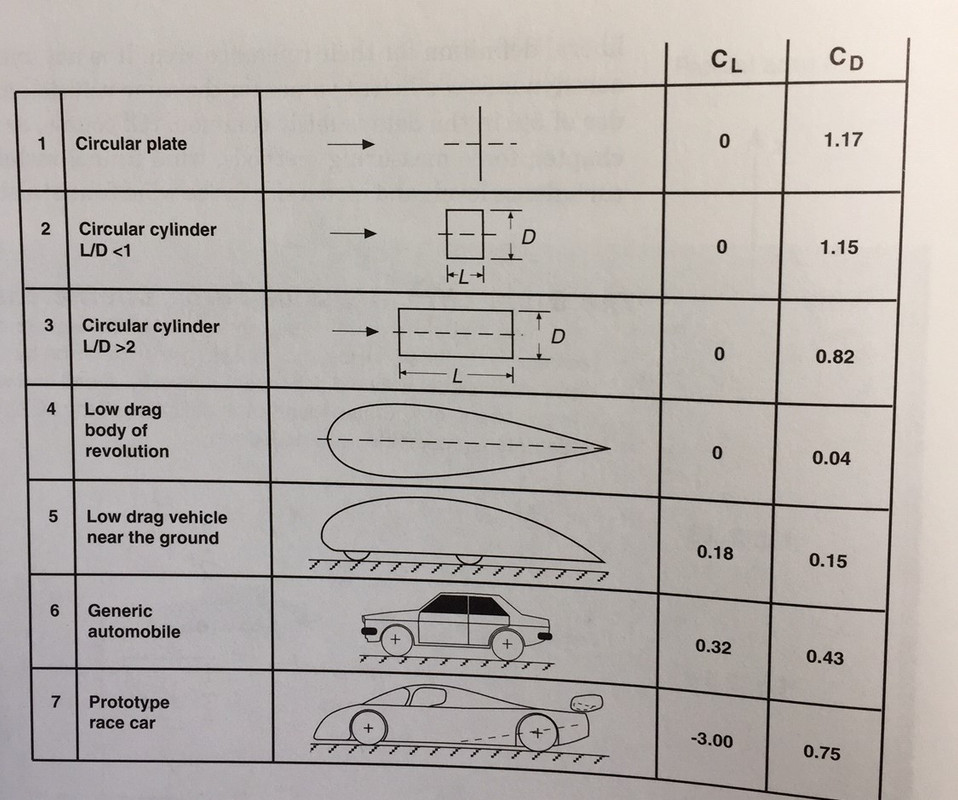
Note the difference in lift between the theoretical 'low drag body of revolution' (Cl = 0) and the 'low drag vehicle near ground' (Cl = 0.18). Once camber is understood as a major cause of lift, of course such a shape will have high lift!
Road Vehicle Aerodynamics, 1975, Skibor-Rylski, Page 69 and 70
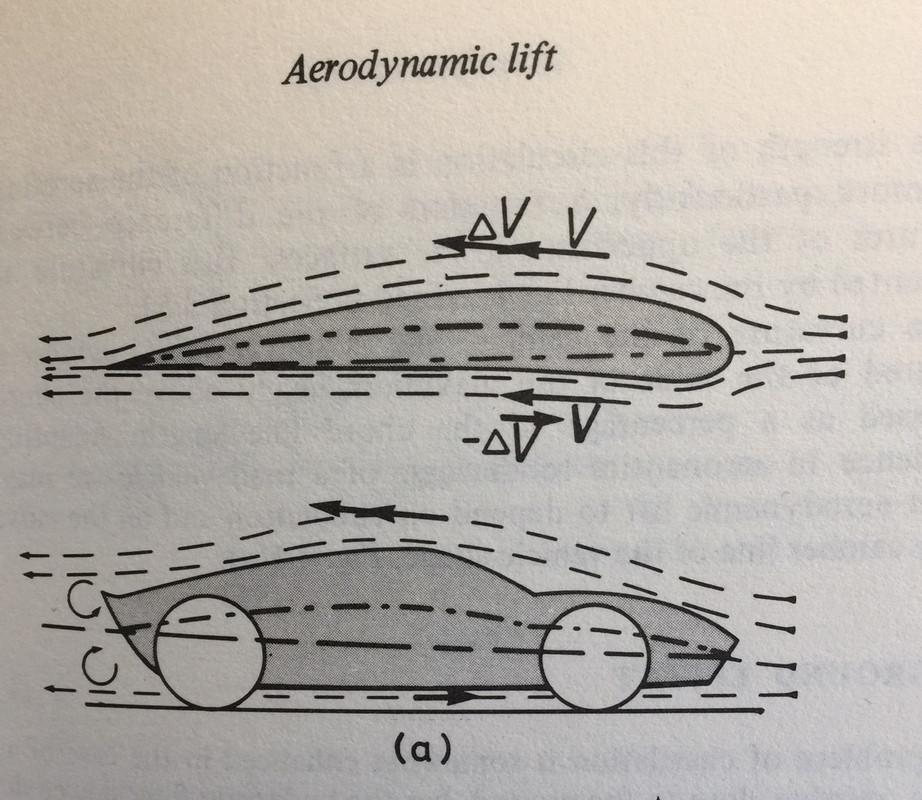
Note the direct parallel that is drawn between the lifting wing and the shape of the car. Also note attached flow on car until separation occurs at end of car ( ie no premature separation). Skibor-Rylski then says on the next page that aero lift depends on the camber line of the vehicle shape.
Modifying the Aerodynamics of Your Road Car, 2018, Edgar, Pages 85 - 91.
Attached flow on upper surfaces of XE Jaguar:
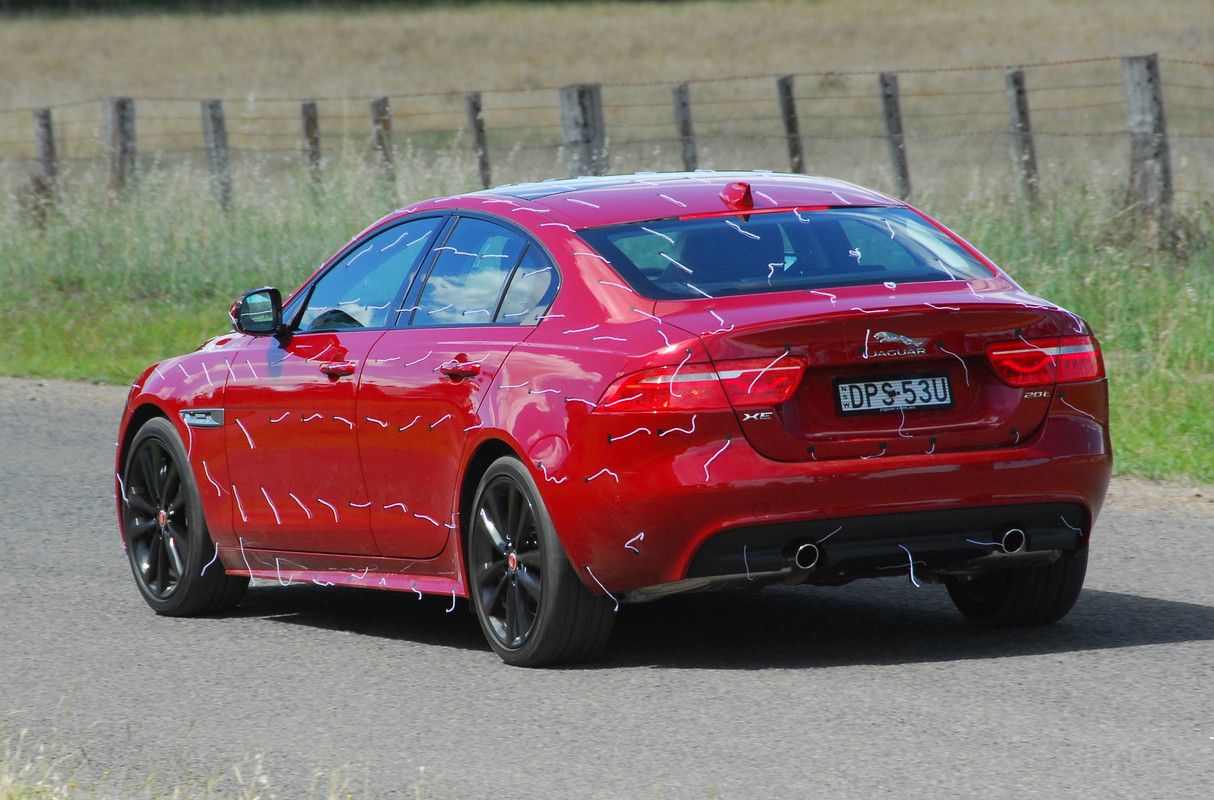
Jaguar CFD showing low pressures where airflow wraps over upper curves (hotter colour = lower pressures):
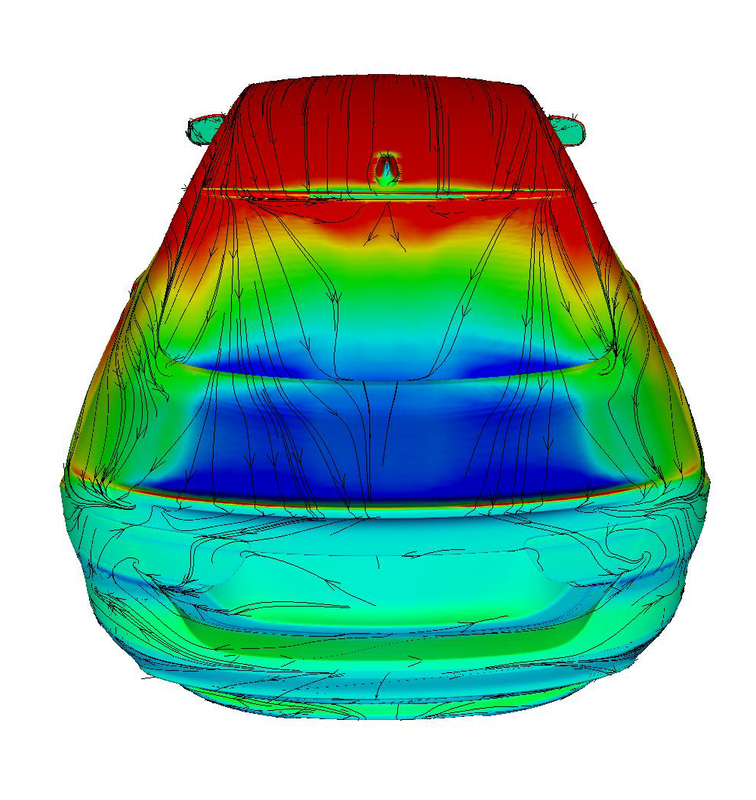
On-road measured pressures showing low pressures where air wraps over upper curves:

The primary cause of lift on road cars is the attached airflow on upper curved surfaces. To argue otherwise is to show a grave misunderstanding of the mechanism of lift on road cars.
Lift depends on the difference in pressures on the underside and topside surfaces. Curved upper surfaces generate low pressures and so lift forces, however these can be offset by generating low pressures under the car through fast flow.
Last edited by JulianEdgar; 05-26-2020 at 01:56 AM..
|
|
|

|
|
The Following User Says Thank You to JulianEdgar For This Useful Post:
|
|
 05-27-2020, 05:19 AM
05-27-2020, 05:19 AM
|
#8 (permalink)
|
|
Banned
Join Date: Nov 2017
Location: Australia
Posts: 2,060
Thanks: 107
Thanked 1,608 Times in 1,137 Posts
|
Getting lowest drag - what you need to know about lift
|
|
|

|
 05-27-2020, 07:37 AM
05-27-2020, 07:37 AM
|
#9 (permalink)
|
|
Cyborg ECU
Join Date: Mar 2011
Location: Coastal Southern California
Posts: 6,302
Thanks: 2,374
Thanked 2,176 Times in 1,471 Posts
|
Quote:
Originally Posted by JulianEdgar

Aerohead's theory is that lift is caused by separation, rather than attached flow. He also suggests that well-streamlined bodies have low lift.
However, in fact it is the airflow wrapping around the upper curves that is the primary cause of lift. Therefore, low drag shapes that have upper curves coming down to a small wake area have higher lift.
Aerodynamics of Road Vehicles, 1987, Hucho (ed), Page 281:

You can see that as the camber (upper curve) of the body becomes greater and longer (ie giving a smaller wake), Cd drops from 0.224 to 0.193 but the CLr (rear lift) rises from -0.1 to 0.056. Well streamlined bodies do not always have lower lift! In fact, because on road cars they need to have greater camber, lift (especially at the rear) is likely to be increased as wake area decreases.
Road Vehicle Aerodynamic Design, 2009, Barnard, Page 32.

You can see that lift is dependent on two aspects - degree of camber and angle of attack. The cambered shape gives more lift at all angles of attack.
Barnard immediately then goes on to this:

Note the reduced pressure over the cambered car shape. (The second and third diagrams show the changed undercar pressures possible with front/rear seals.) Note how premature separation is not even mentioned as a cause of lift.
Race Car Aerodynamics, 1995, Katz, Page 48.

Note the difference in lift between the theoretical 'low drag body of revolution' (Cl = 0) and the 'low drag vehicle near ground' (Cl = 0.18). Once camber is understood as a major cause of lift, of course such a shape will have high lift!
Road Vehicle Aerodynamics, 1975, Skibor-Rylski, Page 69 and 70

Note the direct parallel that is drawn between the lifting wing and the shape of the car. Also note attached flow on car until separation occurs at end of car ( ie no premature separation). Skibor-Rylski then says on the next page that aero lift depends on the camber line of the vehicle shape.
Modifying the Aerodynamics of Your Road Car, 2018, Edgar, Pages 85 - 91.
Attached flow on upper surfaces of XE Jaguar:

Jaguar CFD showing low pressures where airflow wraps over upper curves (hotter colour = lower pressures):

On-road measured pressures showing low pressures where air wraps over upper curves:

The primary cause of lift on road cars is the attached airflow on upper curved surfaces. To argue otherwise is to show a grave misunderstanding of the mechanism of lift on road cars.
Lift depends on the difference in pressures on the underside and topside surfaces. Curved upper surfaces generate low pressures and so lift forces, however these can be offset by generating low pressures under the car through fast flow. |
When I read this post the first time I appreciated the references, but I got stuck on a few things. Your example from Hucho (2cd Edition, p.281) seems to be an image of three differently streamlined bodies. Yet you seem to regard only the last as streamlined. Why? And isn't the difuser angle also relevant, not just the sweep of the top of the body?
A second point you made is contradicted by the evidence you show from Katz’s Race Car Aerodynamics. Katz’s images on p.48 show increases in drag and lift between body shapes 4, 5, and 6. The “low drag body of revolution” has zero lift and the lowest drag. The half-body has the second lowest lift and drag. And the generic contemporary production shape has higher lift and drag than either 4 or 5. Yet you claim that “low drag shapes that have upper curves coming down to a small wake area have higher lift.” But body shape #6 has the higher lift.
Lastly, you gloss aerohead's text this way: “Aerohead's theory is that lift is caused by separation, rather than attached flow.” And you conclude: “The primary cause of lift on road cars is the attached airflow on upper curved surfaces. To argue otherwise is to show a grave misunderstanding of the mechanism of lift on road cars.” But aerohead actually argued almost the same thing as you: “Lift is a function of low pressure acting 'over' a portion of the body.All separation should be at the back of the car. If it's not,it's in a lower pressure regime,as it's at a higher velocity.The closer you get to the windshield the lower the pressure and the higher the lift.”
I'll grant that aerohead sometimes writes haikus, or else with a lot of jargon, but I think his point about lift and pressure was clear enough.
__________________
See my car's mod & maintenance thread and my electric bicycle's thread for ongoing projects. I will rebuild Black and Green over decades as parts die, until it becomes a different car of roughly the same shape and color. My minimum fuel economy goal is 55 mpg while averaging posted speed limits. I generally top 60 mpg. See also my Honda manual transmission specs thread.


|
|
|

|
|
The Following 2 Users Say Thank You to California98Civic For This Useful Post:
|
|
 05-27-2020, 11:38 AM
05-27-2020, 11:38 AM
|
#10 (permalink)
|
|
Master EcoModder
Join Date: Jan 2008
Location: Sanger,Texas,U.S.A.
Posts: 16,514
Thanks: 24,517
Thanked 7,436 Times in 4,817 Posts
|
tuft images
Quote:
Originally Posted by JulianEdgar

Well, you could write lots of stuff that justifies your position on a purely theoretical basis - or you could just look at:
- the tuft images from Porsche
- the actual on-road measurements I have made.
Statements like "Which results in counterflow on the roof,moving forwards towards the windshield,rolling up into eddies,then turbulence,lifting off the roof as separation" are simply rubbish. No tuft testing shows flow separation on the roof on any modern car. None.
(But then a moment ago you explained away the Porsche tuft testing because it didn't match your theory. Those tufts were just an " illusion of 'attached flow'". Talk about mental gymnastics!)
Honestly, why don't you get away from the keyboard and measure some pressures and flows on real cars on real roads? You will very quickly find those measurements don't support your theory.
(You say you have my book. Look on page 80. More measured pressures that don't match your theory!) |
*The tuft flow images cannot be trusted with respect to attached flow. Hucho explains why.
* If you'll ever investigate streamline bodies, you'll finally understand the conditionality of your argument.
*I don't have your book with me,but we could discuss your Jaguar XE:
- the roof-line is a little too fast for its relative length,with respect to the overall body length.
-the TBL is compromised because of this.
-Jaguar reflexed the camber,attempting to lengthen and raise the rear trailing edge of the car, and get it closer to inviscid flow to guarantee re-attachment,and stability.
- they could have just lofted the whole rear of the body, but the stylist might have slammed on the brakes,as Hucho has discussed (see spoiler development of the VW Scirocco).
-----------------------------------------------------------------------------------
* If you'll take a look at the Tata,Jaguar C-X75 of 2011, you'll notice that the designers chose the 'template' to end the body, guaranteeing flow attachment off the boot,and no need of a rear spoiler,just like ALPINE does. It's 'draggy' diffuser area will provide enough high-speed downforce.
------------------------------------------------------------------------------------
* The 911 does not have attached flow beyond the cooling air intake. It has enormous,drag-inducing longitudinal vortices.
* If they'd simply lofted the rear contour out to the tip of the whale-tail they'd have had lower lift and drag (but it would have had violated the 911 'silhouette' expectations of the customer).
*Contemporary Porches have abandoned the early 911 contour altogether and are running closer to the 'template,' reserving the actual 'template' contour for Le Mans and such, when aerodynamics really makes a difference.
__________________
Photobucket album: http://s1271.photobucket.com/albums/jj622/aerohead2/
|
|
|

|
|